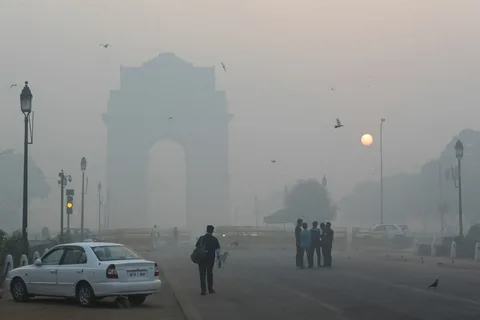Air pollution in Delhi: In the event that there are additional emissions from fireworks, stubble, or waste fires on Diwali, AQI may reach the severe category in other areas.
On Diwali morning, the air quality in Delhi’s Anand Vihar fell into the “severe” category. Pollution levels are expected to rise on Thursday evening, despite the fact that authorities stated that the ban on fireworks would be strictly enforced.
The Central Pollution Control Board (CPCB) reported that Delhi’s 24-hour average Air Quality Index (AQI) was 307 at 4 p.m., up from 268 on Tuesday. PM10 remained a prominent pollutant. Enroll in IIT Delhi’s Design Thinking & Innovation Programme right away!
According to the Indian Institute of Tropical Meteorology (IITM) in Pune, the national capital’s air quality is likely to be “very poor” (AQI 300-400) on Thursday and Friday.
At 8 a.m., Anand Vihar’s AQI (PM10) was 419 on average and 500 on maximum.
Even though the air quality index (AQI) in other parts of Delhi remained largely in the “poor” to “very poor” range, the air quality in these areas may reach the “severe” range on Diwali due to additional emissions from fireworks and waste or stubble fires.
The Decision Support System (DSS) for Air Quality Management states that if stubble burning continues to occur at levels comparable to those of the previous five years, it may account for 15% to 18% of Delhi’s pollution on these dates. This is made worse by winds from the northwest, which could bring smoke into the city, according to the news agency PTI.
The winter air quality in Delhi-NCR is divided into four stages under the Graded Response Action Plan (GRAP), an emergency plan to reduce air pollution: Poor (AQI 201-300), Very Poor (AQI 301-400), Severe (AQI 401-450), and Severe Plus (AQI above 450) are the four stages.
Today’s average area-by-area AQI in Delhi:
Anand Vihar: 419
Ashok Vihar: 368
Burari Crossing: 353
Chandni Chowk: 301
DTU: 281
Dwarka-Sector 8: 359
IGI Airport (T3): 303
ITO: 306
Jahangirpuri:395
Lodhi Road: 259
Mundka: 367
Najafgarh: 281
Narela: 303
North Campus, DU: 334
Patparganj: 350
Punjabi Bagh: 369
RK Puram: 384
Rohini: 357
Wazirpur: 396
Arvind Kejriwal, a former Delhi chief minister and AAP convenor, defended the ban on firecrackers on Wednesday, claiming that it is necessary to protect people from pollution and that there is no “Hindu-Muslim” component to it.
Arvind Kejriwal stated at a press conference, “Even the Supreme Court and the High Court have said people should refrain from bursting crackers in view of the pollution and light earthen lamps instead as Diwali is a festival of lights.”
377 teams were formed to enforce the firework ban: Gopal Rai, the Delhi environment minister, stated that 377 teams have been established to enforce the firecracker ban throughout Delhi. He stated that authorities are communicating with market associations, resident welfare associations, and social organizations to raise awareness.
According to a senior officer with the Delhi Police, all deputy commissioners of police (DCPs) have been instructed to form specialized teams to ensure that no fireworks explode in their respective districts.
According to Mahesh Palawat of Skymet Weather Services, who spoke with PTI, the shift in winds from the south-southeast to the northwest on Diwali could bring smoke from burning stubble into the city.
He stated, “The altered wind direction could further trap pollutants, worsening the air quality if firecrackers are also burst.”
The CPCB shared data from 38 of the 40 air-quality monitoring stations in the capital on Wednesday. Anand Vihar and Mundka remained severe. Anand Vihar and Mundka’s AQI remained “severe,” with readings above 400.
The air quality was recorded as “very poor” in Alipur, Ashok Vihar, Bawana, Burari, Wazirpur, Jahangirpuri, Narela, Nehru Nagar, North Campus, and Vivek Vihar.
The air quality remained “poor” in Delhi’s neighbouring cities of Ghaziabad, Gurugram, Greater Noida, and Noida.
The CPCB, on the other hand, determined that Faridabad’s air quality was “moderate” with a reading of 181.
On November 12, when Diwali was observed, Delhi experienced its best air quality in eight years, with an average AQI of 218.
Particulate matter with a diameter of less than 10 micrometres is known as PM10. Asthma, bronchitis, and other respiratory illnesses could be brought on by inhaling these insignificant liquid or solid particles suspended in the air.





